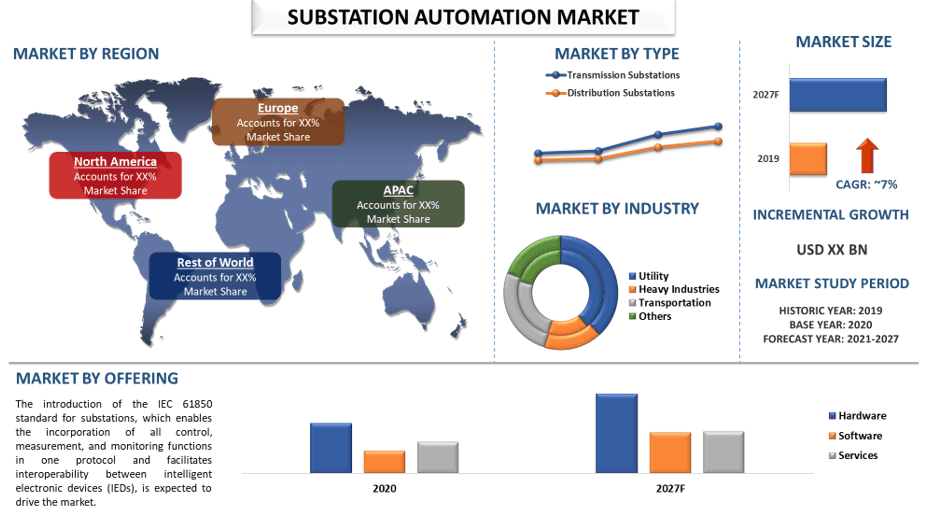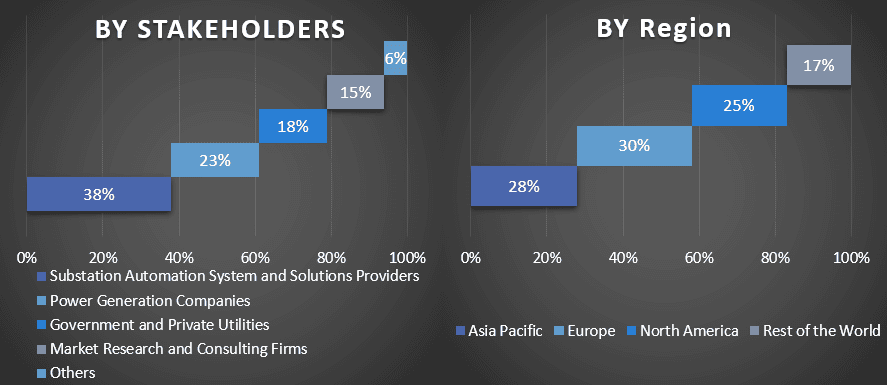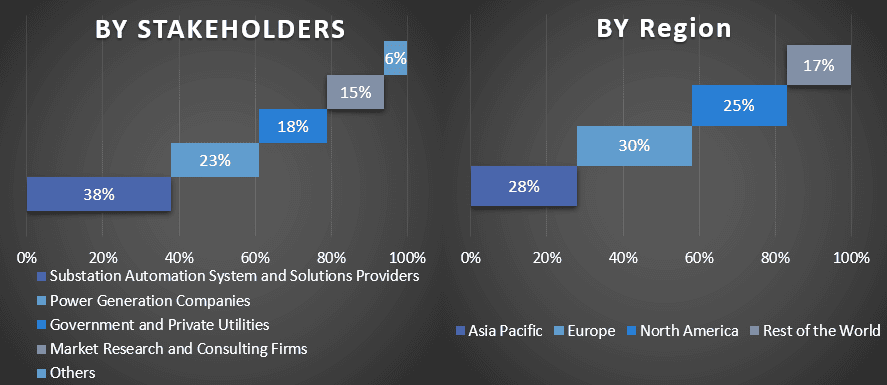Emphasis on Offering (Hardware, Software, and Service); Type (Transmission Substations and Distribution Substations); Industry (Utility, Heavy Industries, Transportation, and Others); and Region/Country

The substation automation market has captured significant market demand and is expected to grow at a CAGR of 7% during the forecast period. This is mainly due to increasing digitization in the utility sector coupled with rising demand of uninterrupted power supply from residential and industrial sectors. This has also forced key stakeholders such as the government and utility companies to investing in expanding their existing electricity transmission and distribution systems. Furthermore, growing emphasis on effectively managing the interruption and customer service by automatically locating feeder faults coupled with decreasing the time required to restore service to unfaulted feeder sections are some other the key factors driving the substation automation demand. In addition, major players in the market are continuously testing and launching substation automation suitable for renewable energy power plants.
Substation automation refers to using data from intelligent electronic devices (IEDs) control & automation capabilities within the substation and control commands from remote users to control power system devices. Thus, rising investments in power transmission and distribution networks coupled with the growing augmentation and modernization of transmission and distribution networks across the globe, are expected to drive the market.
Furthermore, substation automation also offers benefits such as improved reliability by reducing outage duration, better fault detection and diagnostic analysis, and better management of system and component loading. Therefore, growing demand for energy coupled with increasing investment in automation activities by government and utility companies is expected to drive the global substation automation market at a robust CAGR during the forecast period.
ABB Ltd., General Electric Company, Siemens Energy AG, Eaton Corporation Inc., Schneider Electric SA, Schweitzer Engineering Laboratories Inc., CG Power and Industrial Solutions, Cisco Systems Inc., NovaTech Automation, and Trilliant Networks Inc. are some of the key players in the market. Several M&As along with partnerships have been undertaken by these players to facilitate customers with hi-tech and innovative products/technologies.
Insights Presented in the Report
“Amongst Offering, hardware category is expected to hold a significant share of the market in 2020”
Based on offering, the substation automation market is categorized into hardware, software, and service. Amongst these, the hardware category is expected to hold a significant share of the market in 2020 owing to its wide installation and high cost in transmission and distribution networks. However, these systems are extensively used for controlling the voltage throughout load differences in high voltage energy transmission systems through various software specially developed for this purpose. Furthermore, increasing consumption of electricity due to an increasing population, followed by an increasing number of consumers and rapid urbanization, has led to a rise in demand for electricity, thereby raising the growth of substation automations across the globe.
“Amongst Type, distribution substations category is expected to witness a robust CAGR during the forecast period”
Based on type, the market has been categorized into transmission substations and distribution substations. Amongst these, the distribution substations category is expected to witness a robust CAGR during the forecast period. It is mainly owing to the increasing energy demand from the industrial sector, across the globe. For instance, as per the International Energy Outlook, worldwide industrial sector energy consumption is projected to increase by an average of 1.2%/year, from 222 quadrillion British thermal units (Btu) in 2012 to 309 quadrillion Btu in 2040. Furthermore, the rising trend toward the adoption of a renewable energy mix coupled with the growing demand for efficient lines and towers with minimal energy losses is further expected to strengthen the demand for substation automation during the forecast period.
“Amongst Industry, utility sector accounted for the majority share in the global substation automation market”
Based on industry, the market is classified into utility, heavy industries, transportation, and others. In 2020, the utility sector accounted for the majority share in the market owing to increasing government investments in sponsoring renewable sources coupled with surging investment by energy service providers on the up-gradation of transmission and distribution networks across geographies. Moreover, factors such as surging population, coupled with investments in microgrid technology, renewables, and other advanced technologies are driving the transmission and distribution utilities. In addition, with rising investment in hydrogen, renewable natural gas, fuel cells, electric vehicle infrastructure, and carbon capture and storage transmission and distributions utilities require effective substation automation systems.
“APAC to witness significant growth during the forecast period”
APAC region has been witnessing some of the largest T&D expansions due to rapidly increasing demand in countries such as India and China. In addition, an upsurge in renewable power generation projects is expected to positively influence the market demand for substation automation systems. China is investing in expanding its existing electricity transmission and distribution systems to cater to the rising electricity demand due to rapid urbanization and industrialization in the country. Thus, the rise in the installation of new transmission lines and new substations to reduce the energy demand and supply gap in major economies of the region is expected to drive the market for substation.
Reasons to buy this report:
Customization Options:
Global substation automation market can further be customized as per the requirement or any other market segment. Besides this, UMI understands that you may have your own business needs, hence feel free to connect with us to get a report that completely suits your requirements.
1. Market Introduction
2. Research Methodology Or Assumption
3. Market Synopsis
4. Executive Summary
5. Impact Of Covid-19 On The Substation Automation Market
6. Substation Automation Market Revenue (usd Bn), 2019-2027f
7. Market Insights By Offering
8. Market Insights By Type
9. Market Insights By Industry
10. Market Insights By Region
11. Substation Automation Market Dynamics
12. Substation Automation Market Opportunities
13. Substation Automation Market Trends
14. Demand And Supply-side Analysis
15. Competitive Scenario
16. Company Profiled
17. Disclaimer
Research Methodology for the Global Substation Automation Market Analysis (2021-2027)
Analyzing the historical market, estimation of the current market, and forecasting the future market of the global substation automation market were the three major steps undertaken to create and analyze the adoption of substation automation in major regions globally. Exhaustive secondary research was conducted to collect the historical market numbers and estimate the current market size. Secondly, to validate these insights, numerous findings and assumptions were taken into consideration. Moreover, exhaustive primary interviews were also conducted, with industry experts across the value chain of the global substation automation market. Post assumption and validation of market numbers through primary interviews, we employed a top-down/bottom-up approach to forecasting the complete market size. Thereafter, market breakdown and data triangulation methods were adopted to estimate and analyze the market size of segments and sub-segments the industry pertains to. Detailed methodology is explained below:
Seek More Details About Research Methodology
Analysis of Historical Market Size
Step 1: In-Depth Study of Secondary Sources:
Detail secondary study was conducted to obtain the historical market size of substation automation market through company internal sources such as annual report & financial statements, performance presentations, press releases, etc., and external sources including journals, news & articles, government publications, competitor publications, sector reports, third-party database, and other credible publications.
Step 2: Market Segmentation:
After obtaining the historical market size of the substation automation market, we conducted a detailed secondary analysis to gather historical market insights and share for different segments & sub-segments for major regions. Major segments included in the report as offering, type, and industry. Further country-level analyses were conducted to evaluate the overall adoption of testing models in that region.
Step 3: Factor Analysis:
After acquiring the historical market size of different segments and sub-segments, we conducted a detailed factor analysis to estimate the current market size of the substation automation market. Further, we conducted factor analysis using dependent and independent variables such as various offering, type, and industry of substation automation equipment. A thorough analysis was conducted for demand and supply-side scenarios considering top partnerships, merger and acquisition, business expansion, and product launches in the substation automation market sector across the globe.
Current Market Size Estimate & Forecast
Current Market Sizing: Based on actionable insights from the above 3 steps, we arrived at the current market size, key players in the global substation automation market, and market shares of the segments. All the required percentage shares split, and market breakdowns were determined using the above-mentioned secondary approach and were verified through primary interviews.
Estimation & Forecasting: For market estimation and forecast, weights were assigned to different factors including drivers & trends, restraints, and opportunities available for the stakeholders. After analyzing these factors, relevant forecasting techniques i.e., top-down/bottom-up approach was applied to arrive at the market forecast about 2027 for different segments and sub-segments across the major markets globally. The research methodology adopted to estimate the market size encompasses:
Market Size and Share Validation
Primary Research: In-depth interviews were conducted with the Key Opinion Leaders (KOLs) including Top Level Executives (CXO/VPs, Sales Head, Marketing Head, Operational Head, and Regional Head, Country Head, etc.) across major regions. Primary research findings were then summarized, and statistical analysis was performed to prove the stated hypothesis. Inputs from primary research were consolidated with secondary findings, hence turning information into actionable insights.
Split of Primary Participants in Different Regions

Market Engineering
Data triangulation technique was employed to complete the overall market estimation and to arrive at precise statistical numbers of each segment and sub-segment of the global substation automation market. Data was split into several segments & sub-segments post studying various parameters and trends in the areas of offering, type, and industry in the global substation automation market.
The main objective of the global substation automation Market Study
The current & future market trends of global substation automation market were pinpointed in the study. Investors can gain strategic insights to base their discretion for investments from the qualitative and quantitative analysis performed in the study. Current and future market trends were determined the overall attractiveness of the market at a regional level, providing a platform for the industrial participant to exploit the untapped market to benefit as a first-mover advantage. Other quantitative goals of the studies include:

Customers who bought this item also bought